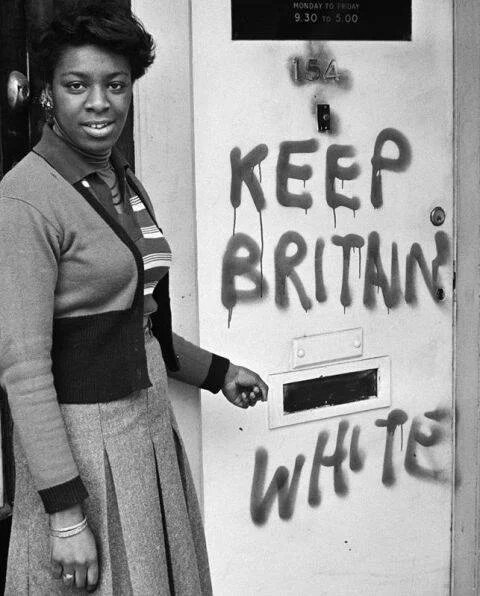
The summer of 2020 will be remembered for the period that saw the largest anti-racist protests in British history. Tens of thousands have marched in major cities such as Manchester, London, Birmingham and Bristol, while smaller towns and villages have also seen vigils and solidarity gatherings around the slogan ‘Black Lives Matter’. Dr. Adam Elliott-Cooper, sociologist at Greenwich University in London, gives an overview about the history and current state of the BLM movement and institutional racism in the UK.

Racism, the British Empire and the Legacy of Colonialism
While the focus of the protesters challenging policing and racial violence echoes the campaigns of previous decades, Britain’s imperial monuments are also the target of protesters. These actions have forced the nation to confront a deeper history of how its racial past has shaped 21st-century injustices. On the BBC’s flagship current affairs show Newsnight, the presenter made an assertion which is by now well-rehearsed across Western Europe: “But you’re not putting Britain and America on the same footing ... our police aren’t armed. The legacy of slavery is not the same”. For many European nations, racism against Black people is seen as a crude American aberration, finding its way to Europe only when Africans, Caribbeans and Asians began to migrate there in significant numbers after World War 2. But the European colonial expansion that brought slavery, genocide and exploitation to Africa, the Americas and South Asia means that racism has been fundamental to the governance used by Western European nations such as Britain for centuries. The geographical distance between Europe and its colonies has enabled it to create a conceptual distance between racism and its own self-image. Britain, once the largest slave-trading nation in history, boasting the most vast and profitable empire the world has ever known, is no exception.
Racism was vital to controlling the large populations that Britain colonised, and to justifying the violence and exploitation that accompanied it. From the slave plantations of the Caribbean and the repression of rebellions in India, to the violent end of Empire in Kenya and Malaya, racial thinking has been fundamental to the policing of British subjects. Framing colonised people as predisposed to laziness, deviance and criminality justified the disciplinary forces of enslavement, exploitation, civilising missions and punishment. Indeed, it justified colonisation itself, assuming the colonised populations unfit for independent rule. We should therefore be unsurprised that statues of slave traders such as Edward Colston (in Bristol), colonialists such as Cecil Rhodes (in Oxford) and powerful advocates of imperialism such as Winston Churchill (in London) have been among the targets of the anti-racist protesters who have taken to the streets since June. They have forced Britain to concede that racism did not begin with 20th-century Black migration, unsettling a fantasy of cultural homogeneity and social tranquillity. Rather, racism began when Britain came to the rest of the world, not as migrants seeking a better life, but with imperial ambitions for land, resources, power and wealth.
Black Political Resistance on the British Mainland
Migration from Britain’s colonies in the Caribbean, Africa and Asia was crucial in the rebuilding of the country after World War 2, in particular the maintenance of its transport network and the establishment of the National Health Service. However, as these colonial and post-colonial subjects migrated to the ‘mother country’, the racist ideas and modes of governance that had been used to control them in the colonies came home. ‘No dogs, no blacks, no Irish’ was displayed in the windows of houses with rooms to rent, while the Conservative Party won a seat in the 1964 general election on the slogan ‘If you want a coloured for a neighbour, vote Labour’. Exploitation of Black and Asian workers was common, with low wages and poor conditions for women of South Asian heritage leading to a strike at the Grunwick film processing factory in west London in the 1970s. But it was criminalisation which remained the most powerful weapon of racism, framing "coloured" migrants as stowaways, pimps, drug dealers, muggers, political extremists and gangsters. This fuelled the policing of Black communities, in which Black young people were targeted with the ‘sus’ powers of the 1970s and 1980s, the power for police to apprehend anyone they ‘suspected’ of carrying out an offence.
The racism of government and police bolstered far-right groups, which brought racial violence to the streets. Black and Asian homes and businesses were regularly targeted by fascist groups such as the National Front. Following a string of local attacks on Black people and their homes, in February 1981 there was a house fire at a sixteenth birthday party in New Cross, south-east London. Thirteen young Black people lost their lives, but the police refused to investigate the fire as suspicious, or take seriously their concerns of another racist arson attack on the Black community. Over the weeks that followed, Black activist groups toured the country, galvanising people to march in protest against the racism from both the far right and the police. This would be the largest Black protest in Britain until the Black Lives Matter protests of 2020. Yet they were not the only Black mobilisations that took place in 1981 – in spring of that year urban rebellions had erupted across English cities as young people revolted against the ‘sus’ laws which had blighted their communities. This combination of anti-racist organisations, mass marches and spontaneous uprisings made the 1970s and 1980s definitive decades, in which Black people asserted themselves as part of Britain, refusing to yield to the racism they faced.
Institutional Racism and the British Criminal Justice System
In the aftermath of this phase of Black political resistance, the British government was forced to take anti-racism more seriously. Policy and legislation against racial discrimination were extended, while multiculturalism was officially embraced by the state. Following police inaction after the racist killing of Black teenager Stephen Lawrence in 1993, a community campaign exposed the police as institutionally racist. This led to the Macpherson Report, published in 1999, which showed that racist policing is not just the result of individual racists but is embedded in the criminal justice system, whereby the normal functioning of policing produces racist outcomes.
Yet despite the reforms, inquiries and policy changes made to policing, the improvement is only ever superficial. By the second decade of the 21st century, Black people are still up to twelve times more likely to be stopped and searched by police, and they are more likely to be arrested and charged for drug-related offences than their white counterparts. As Britain’s prison population almost doubles over a 30-year period, Black people are incarcerated at the same rate as African Americans in the U.S. This system of police racism is bolstered by a ‘war on terror’ which targets Muslims and perceived Muslims, a ‘war on gangs’ which disproportionately targets Black communities, and a ‘hostile environment’ policy which includes a massive increase in the imprisonment of undocumented people. It is in this context that Black Lives Matter UK emerges, arguing that the police, prison and border system is beyond reform, and that radical action is needed.
Black Lives Matter UK - History and Demands of the Movement
In 2014/15, when protests erupted across the U.S. after police killings in Ferguson, Baltimore and New York, solidarity protests were organised in British cities. Hundreds marched through shopping districts, shutting down these spaces of commerce and drawing attention from the press and other activists. While the British media cover police killings and racism in the U.S. extensively, similar deaths at the hands of British police often receive less critical coverage. The mobilisations in solidarity with the U.S. were a chance for activists to draw attention to police violence in Britain. The families of people such as Mark Duggan and Sean Rigg joined the protests, telling the crowds about how their loved ones had died at the hands of police in Britain, and their campaigns for justice. By 2016, UK Black Lives Matter was established and was using direct action to protest against deportations of migrants,police killings and prison expansion in Britain. They shut down major roads, transport networks and even an airport to protest against the disproportionate effects of pollution on Black communities and climate change across the Global South. Their demands were radical: an end to deportations, an end to immigration detention, an end to police stop-and-search, and justice for those killed at the hands of police. As the protests subsided, UK-BLM organisers have been involved in a range of community organising and grassroots education projects. This work doesn’t grab headlines, and much of the press assumed they were dormant or disbanded. But running workshops in schools and youth clubs, building links of solidarity with campaigns for fair housing, migrants’ rights and climate justice, have been vital in developing what was to come next.
No one could have predicted the protests in solidarity with Black Lives Matter in 2020. As people across the country gathered in numbers never seen at anti-racist protests in Britain, newer, more radical demands were proposed, for example defunding the police. Following in the footsteps of the United States, Britain was massively expanding its prison system, giving police more power and weapons while justifying these processes through racist campaigns against racialised suspect communities purportedly harbouring gangsters, terrorists and ‘illegal’ immigrants. And, as in the U.S., this expansion of policing and prisons was having no positive effect on public safety. The police and prison systems had undergone numerous policy changes, introduced oversight bodies and had been scrutinised by inquiries. However, after decades of expansion, only one conclusion could be drawn: the police and prison system are beyond reform.
Community and Social Services Instead of Prisons
Not only are the police ineffective in reducing levels of harm in society, they actually bring more violence to communities, through stops, searches, arrests, raids and detentions, as well as the crimes of brutality for which they are rarely held to account. Black Lives Matter protesters began to use the language of abolition – what would a world look like in which police and prisons were no longer needed? While the press and politicians wilfully misinterpreted these demands as an immediate end to police and prisons, Black Lives Matter have been arguing for reforms, which reduce our reliance on them to solve social problems.
Demands include investment in youth services – over 750 youth clubs have been closed as part of Britain’s economic austerity programme, introduced in order to cut public spending after the bailout of the banks in 2008. The youth workers who lost their jobs are vital trusted adults who can offer assistance to vulnerable young people experiencing mental health problems, abuse in the home or pressure to participate in criminalised activity. They can provide early interventions before young people come into contact with the criminal justice system. People with special educational needs, a history of mental health problems, child abuse survivors, experience of school exclusion or homelessness are all more likely to end up in prison. Incarcerating such people does not just fail to deal with the root causes of society’s problems – it exacerbates them. Cuts to mental health provision, trade union influence, social care, further and higher education funding, domestic violence services, social housing and a range of other vital public services have meant that lower-income and vulnerable people are not being provided with the support that they need. The demands made by Black Lives Matter activists to erode the power of the police and prison system at the same time seeks to empower community and social services which can prevent violence and other forms of harm before they arise. The police are beyond reform. It is through envisioning a world in which they are obsolete that economic, social and political demands can be made to build a society, which is not just anti-racist but more peaceful and fair for everyone.




